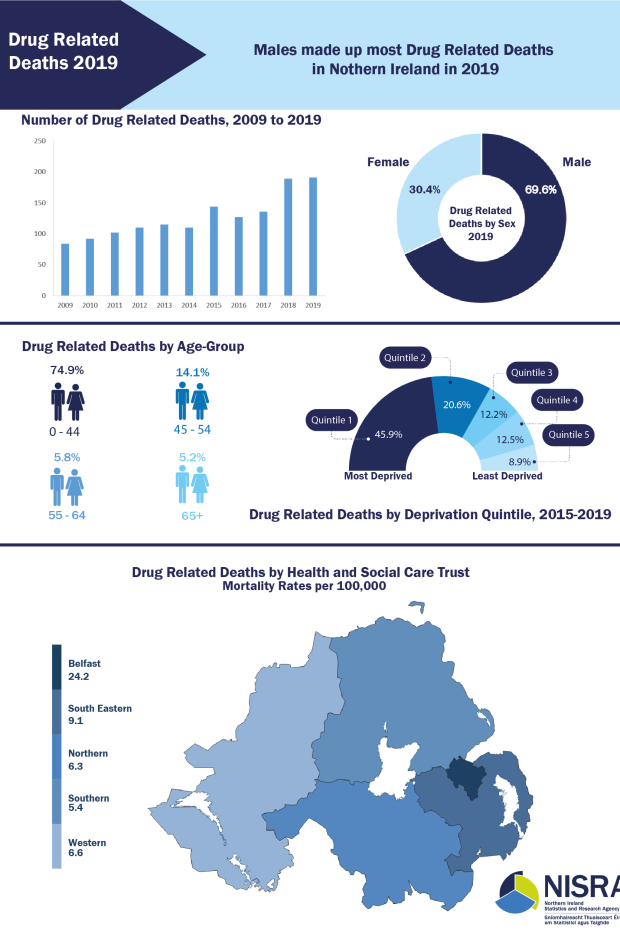Drug Related Deaths in Northern Ireland, 2009-2019
Date published:
Topics:
Cause of Death,
Drug-Related Deaths
Tables containing data on drug related deaths and drug misuse deaths registered during 2009-2019 in Northern Ireland were released at 9.30am today.
 Key Points
Key Points

- There were 191 drug-related deaths registered in Northern Ireland in 2019, the highest number recorded since the time series began in 1997. Almost half (45.5%) of these deaths were of men aged 25-44.
- The 2019 total (191) is more than double that recorded a decade ago (84) but is similar to the total of 189 in 2018. Drug-related deaths accounted for 10.1 deaths per 100,000 people in 2019. In terms of all deaths registered in Northern Ireland in 2019 (15,758), drug-related deaths accounted for 1.2% of the total.
- The figures show that the drug-related mortality rate remained relatively constant between 2018 and 2019 for both males and females. The rate for males decreased from 14.4 per 100,000 males to 14.3; for females the equivalent rate rose from 5.9 per 100,000 females to 6.0. Males accounted for 69.6% (133) of the 191 drug-related deaths registered in Northern Ireland in 2019.
- Of the 191 drug-related deaths in 2019, 62 (32.5%) were in the 25-34 age group with a further 53 (27.7%) in the 35-44 age group. These figures equate to age-specific, drug-related mortality rates of 24.9 deaths per 100,000 people aged 25-34 and 22.0 deaths per 100,000 people aged 35-44.
- The majority (86.4%) of all drug-related deaths in 2019 were classed as drug-misuse deaths (where the underlying cause is drug poisoning, drug abuse or drug dependence and where any of the substances controlled under the Misuse of Drugs Act (1971) are involved), similar to 2018 (85.2%). The rate of death relating to drug misuse has increased from 3.2 deaths per 100,000 people in 2009 to 8.7 deaths per 100,000 people in 2019.
- More than half (56.0%) of drug-related deaths in 2019 involved three or more drugs. In contrast, in 2009, 70.2% of drug-related deaths involved one or two drugs.
- Since 2010, over half of drug-related deaths each year have involved an opioid. In 2019, 128 drug-related deaths had an opioid mentioned on the death certificate. Heroin and morphine were the most frequently mentioned opioids in 2019, connected to 46 drug-related deaths, up from 40 in 2018 and the highest number on record.
- Drug-related deaths involving cocaine increased from 28 in 2018 to 37 in 2019, the highest level on record.
- Diazepam was listed in 36.6% of all drug-related deaths in 2019, a decrease from previous years. Drug-related deaths involving pregabalin, however, have risen consistently since its first appearance in these statistics in 2013; the annual number of deaths involving this controlled substance rose from 9 in 2016, to 54 in 2018 to 77 in 2019. The latest figure sees pregabalin appearing in 40.3% of all drug related deaths.
- The proportion of all drug-related deaths that also mentioned alcohol on the death certificate decreased from 23.3% in 2018 to 16.2% in 2019. This percentage is lower than the average proportion over the previous decade, 2009-2018 (24.1%).
- The statistics also indicate that there are notably higher numbers of drug-related deaths in areas of deprivation across Northern Ireland. People living in the most deprived areas are five times more likely to die from a drug-related death than those in the least deprived areas.
The tables are available from the drug related deaths in Northern Ireland webpage
If you would like to receive alerts about Vital Statistics releases, please email demography@nisra.gov.uk